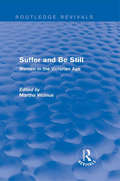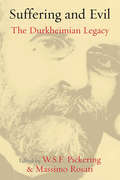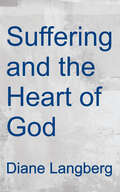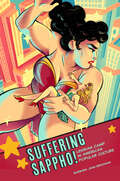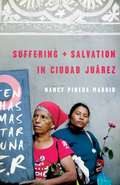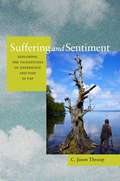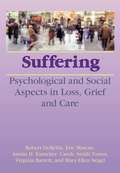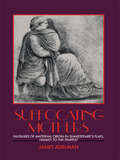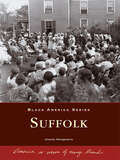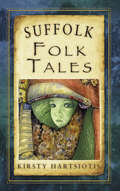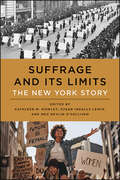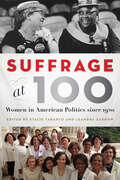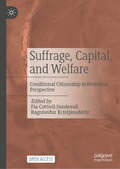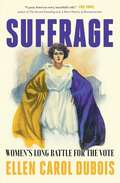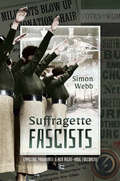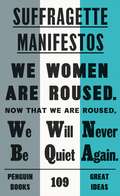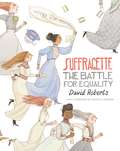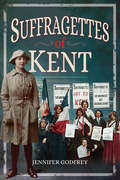- Table View
- List View
Suffer and Be Still: Women in the Victorian Age (Routledge Revivals)
by Martha VicinusFirst published in 1972, this book contains a collection of ten essays that document the feminine stereotypes that women fought against, and only partially erased, a hundred years ago. In an introductory essay, Martha Vicinus describes the perfect Victorian lady, showing that the ideal was a combination of sexual innocence, conspicuous consumption and worship of the family hearth. Indeed, this model in some form was the ideal of all classes as the perfect lady’s only functions were marriage and procreation. The text offers a valuable insight into Victorian culture and society.
Suffering And Evil
by Massimo Rosati W.S.F. PickeringUntil recently the subject of suffering and evil was neglected in the sociological world and was almost absent in Durkheimian studies as well. This book aims to fill the gap, with particular reference to the Durkheimian tradition, by exploring the different meanings that the concepts of evil and suffering have in Durkheim's works, together with the general role they play in his sociology. It also examines the meanings and roles of these concepts in relation to suffering and evil in the work of other authors within the group of the Année sociologique up until the beginning of World War II. Finally, the Durkheimian legacy in its wider aspects is assessed, with particular reference to the importance of the Durkheimian categories in understanding and conceptualizing contemporary forms of evil and suffering.
Suffering And The Heart Of God: How Trauma Destroys And Christ Restores
by Diane LangbergWhen someone suffers through trauma, can healing happen? And, if yes, how does it happen? Dr. Diane Langberg tackles these complex and difficult questions with the insights she has gained through more than forty years of counseling those whose lives have been destroyed by trauma and abuse. Her answer carefully explained in Suffering and the Heart of God is Yes, what trauma destroys, Jesus can and does restore.
Suffering Narratives of Older Adults: A Phenomenological Approach to Serious Illness, Chronic Pain, Recovery and Maternal Care (Routledge Advances in the Medical Humanities)
by Mary Beth MorrisseyIn Suffering Narratives of Older Adults, Mary Beth Quaranta Morrissey turns to the traditions of phenomenology, humanistic psychology and social work to provide an in-depth exploration of the deep structure of the suffering experience. She draws upon the notion of maternal holding to develop an original construct of maternal affordances – the ground of possibility for human development, agency and relational practices. The conceptual analysis is based on the life narratives of several elders receiving chronic care in facility environments. Creating new fields of communication for patients, their family members and health professionals in processes of reflection and shared decision making, this book builds on knowledge about suffering to help guide ethical action in preventing and relieving chronic pain and improving systems of care. It offers a phenomenological approach to understanding the maternal as a primary domain of moral experience in serious illness and suffering, and implications for policy, practice and research. A series of applied chapters, looking at individual experiences of suffering and care experiences, present critical areas of ethical inquiry, including: pain and suffering maternal relational ethics evaluation and moral deliberation about care options decision-making and moral agency end-of-life experiences of care. Exploring how an ecological relational perspective grounded in phenomenology may provide fruitful alternatives to traditional frameworks in bioethics, this is an important contribution to the ongoing development of an ecological ethic of care. It will be of interest to scholars and students of bioethics and phenomenological methods in the health and human services, as well as practitioners in the field.
Suffering Sappho!: Lesbian Camp in American Popular Culture
by Barbara Jane BrickmanAn ever-expanding and panicked Wonder Woman lurches through a city skyline begging Steve to stop her. A twisted queen of sorority row crashes her convertible trying to escape her queer shame. A suave butch emcee introduces the sequined and feathered stars of the era’s most celebrated drag revue. For an unsettled and retrenching postwar America, these startling figures betrayed the failure of promised consensus and appeasing conformity. They could also be cruel, painful, and disciplinary jokes. It turns out that an obsession with managing gender and female sexuality after the war would hardly contain them. On the contrary, it spread their campy manifestations throughout mainstream culture. Offering the first major consideration of lesbian camp in American popular culture, Suffering Sappho! traces a larger-than-life lesbian menace across midcentury media forms to propose five prototypical queer icons—the sicko, the monster, the spinster, the Amazon, and the rebel. On the pages of comics and sensational pulp fiction and the dramas of television and drive-in movies, Barbara Jane Brickman discovers evidence not just of campy sexual deviants but of troubling female performers, whose failures could be epic but whose subversive potential could inspire. Supplemental images of interest related to this title: George and Lomas; Connie Minerva; Cat On Hot Tin; and Beulah and Oriole.
Suffering and Salvation in Ciudad Juarez
by Nancy Pineda-MadridSince 1993 more than six hundred girls and women have been brutally slain in Ciudad Juárez in internationally condemned violence for which no one has been arrested. Nancy Pineda-Madrid's powerful reflection on this destructive and dehumanizing violence, based on first-hand knowledge of the traumatic situation in Juárez, attempts to understand the cultural, economic, and even religious factors that feed the violence. She detects in the social suffering of the women there a yearning for release, justice, and healing in their quest for salvation through solidarity and community practices that resist rather than acquiesce to the violence.
Suffering and Sentiment: Exploring the Vicissitudes of Experience and Pain in Yap
by C. Jason ThroopSuffering and Sentiment examines the cultural and personal experiences of chronic and acute pain sufferers in a richly described account of everyday beliefs, values, and practices on the island of Yap (Waqab), Federated States of Micronesia. C. Jason Throop provides a vivid sense of Yapese life as he explores the local systems of knowledge, morality, and practice that pertain to experiencing and expressing pain. In so doing, Throop investigates the ways in which sensory experiences like pain can be given meaningful coherence in the context of an individual's culturally constituted existence. In addition to examining the extent to which local understandings of pain's characteristics are personalized by individual sufferers, the book sheds important new light on how pain is implicated in the fashioning of particular Yapese understandings of ethical subjectivity and right action.
Suffering for Territory: Race, Place, and Power in Zimbabwe
by Donald S. MooreSince 2000, black squatters have forcibly occupied white farms across Zimbabwe, reigniting questions of racialized dispossession, land rights, and legacies of liberation. Donald S. Moore probes these contentious politics by analyzing fierce disputes over territory, sovereignty, and subjection in the country's eastern highlands. He focuses on poor farmers in Kaerezi who endured colonial evictions from their ancestral land and lived as refugees in Mozambique during Zimbabwe's guerrilla war. After independence in 1980, Kaerezians returned home to a changed landscape. Postcolonial bureaucrats had converted their land from a white ranch into a state resettlement scheme. Those who defied this new spatial order were threatened with eviction. Moore shows how Kaerezians' predicaments of place pivot on memories of "suffering for territory," at once an idiom of identity and entitlement. Combining fine-grained ethnography with innovative theoretical insights, this book illuminates the complex interconnections between local practices of power and the wider forces of colonial rule, nationalist politics, and global discourses of development. Moore makes a significant contribution to postcolonial theory with his conceptualization of "entangled landscapes" by articulating racialized rule, situated sovereignties, and environmental resources. Fusing Gramscian cultural politics and Foucault's analytic of governmentality, he enlists ethnography to foreground the spatiality of power. Suffering for Territory demonstrates how emplaced micro-practices matter, how the outcomes of cultural struggles are contingent on the diverse ways land comes to be inhabited, labored upon, and suffered for.
Suffering in Silence: The Links between Human Rights Abuses and HIV Transmission to Girls in Zambia
by Human Rights WatchSexual abuse of girls in Zambia fuels the HIV/AIDS epidemic and the strikingly higher HIV prevalence among girls than boys, Human Rights Watch said today. Concerted national and international efforts to protect the rights of girls and young women are key to curbing the AIDS epidemic's destructive course.
Suffering: Psychological and Social Aspects in Loss, Grief, and Care
by Robert DeBellis, Eric Marcus, Austin H. Kutscher, Carole Smith Torres, Virginia Barrett, and Mary-Ellen SiegelLearn to help others understand, cope with, and even overcome emotional and physical suffering. Suffering: Psychological and Social Aspects in Loss, Grief, and Care is a unique and insightful volume of observations, anecdotes, and case studies about suffering. In this important book, doctors, nurses, teachers, funeral directors, and members of the clergy discuss the crucial physical, emotional, and psychological issues that patients and their families must confront when death is imminent. They address a variety of topics including terminal illness, chronic illness, loss, grief, and pain. Ideal for professionals who work with dying people and their families, Suffering highlights topics that are particularly common when working with AIDS patients, cancer patients, children, the elderly, and the mentally ill.
Sufficiency Thinking: Thailand's gift to an unsustainable world
by Gayle C. AveryOur world is under pressure, with growing inequalities in wealth and access to food and clean water. We depend too heavily on polluting fuels and diminishing natural resources. Traditional cultural practices are being swamped by global popular culture.The Thai model of sufficiency thinking aims to transform the mindset of a whole population to achieve the seemingly impossible: enriching everyone's lives in a truly sustainable way.Innovative management practices developed by King Bhumibol Adulyadej of Thailand have been applied across Thailand in agriculture, education, business, government and community organisations for over two decades.In this book, chapters written by eminent Thai scholars explain sufficiency thinking and review its implementation in different sectors including community development, business, agriculture, health care, schools, and even in prisons.Is Thailand unique in having discovered the holy grail of a more responsible form of capitalism? No, it is not, but it is the first country whose government has adopted this kind of thinking as national policy.'...we obviously need to revise dramatically our thinking about the outlines of a just economy and a decent society in which everyone can lead dignified lives. Sufficiency Thinking provides creative approaches to this quandary and this important volume is a brilliant addition to the growing literature critical of mainstream business-as-usual ideology.' - John Komlos, Professor Emeritus, University of Munich
Suffocating Mothers: Fantasies of Maternal Origin in Shakespeare's Plays, Hamlet to the Tempest
by Janet AdelmanAn original reading of Shakespeare's plays illuminating his negotiations with mothers, present and absent, and tracing the genesis of Shakespearean tragedy and romance to a psychologized version of the Fall.
Suffolk (Black America Series)
by Annette MontgomeryAfter the Civil War, African Americans throughout Suffolk and Nansemond County fought against injustice by demanding equality before the law, the right to vote, and equal access to schools, employment, and professions. Because of their tolerance and sense of fortitude, they were able to own land and businesses and to establish churches, schools, and social organizations that paved the way for generations to come.
Suffolk Folk Tales (Folk Tales: United Kingdom)
by Kirsty HartsiotisWith its wild eroding sea, its gentle rolling fields and tall churches, Suffolk is a county of contrasts. It may seem a kindly and civilised place, but in that sea, in the reed beds, the woods and even down dark town streets lurk strange beasts, ghosts and tricksters.These thirty traditional tales retold by storyteller Kirsty Hartsiotis take you into a hidden world of green children and wildmen, of lovers from beyond the grave and tricksy fairy folk. Shaped by generations of Suffolk mardle and wit, in these stories you'll discover the county's last dragon, the secret behind Black Shuck, saintly King Edmund and heroic King Raedwald, haunted airfields, broken-hearted mermaids and the exploits of the county's cunning folk. Embark on this journey around Suffolk and you'll find you're never far from a story.
Suffrage and Its Legacy in the Nordics and Beyond: Gender, Institutional Constraints and Feminist Strategies (Gender and Politics)
by Lenita Freidenvall Josefina EriksonThis book reflects on the centennial of women's suffrage in the Nordic region and beyond, by exploring its relevance to political gender equality today and the conditions for feminist institutional change. The book brings together historians and political scientists to provide a long-term historical perspective that lays the groundwork for theoretical development. In this regard, the book makes two key contributions: it furthers our understanding of different types of gendered institutional constraints on women’s political inclusion and elaborates feminist institutional strategies to counter these constraints.
Suffrage and Its Limits: The New York Story
by Kathy HochulSuffrage and Its Limits offers a unique interdisciplinary overview of the legacy and limits of suffrage for the women of New York State. It commemorates the state suffrage centennial of 2017, yet arrives in time to contribute to celebrations around the national centennial of 2020. Bringing together scholars with a wide variety of research specialties, it initiates a timely dialogue that links an appreciation of accomplishments to a clearer understanding of present problems and an agenda for future progress. The first three chapters explore the state suffrage movement, the 1917 victory, and what New York women did with the vote. The next three chapters focus on the status of women and politics in New York today. The final three chapters take a prospective look at the limits of liberal feminism and its unfinished agenda for women's equality in New York. A preface by Lieutenant Governor Katherine Hochul and a final chapter by activist Barbara Smith bookend the discussion. Combining diverse approaches and analyses, this collection enables readers to make connections between history, political science, public policy, sociology, philosophy, and activism. This study moves beyond merely celebrating the centennial to tackle women's issues of today and tomorrow.
Suffrage at 100: Women in American Politics since 1920
by Stacie Taranto and Leandra ZarnowSuffrage at 100 looks at women's engagement in US electoral politics and government over the one hundred years since the ratification of the Nineteenth Amendment.In the 2018 midterm elections, 102 women were elected to the House and 14 to the Senate—a record for both bodies. And yet nearly a century after the ratification of the Nineteenth Amendment, the notion of congressional gender parity by 2020—a stated goal of the National Women's Political Caucus at the time of its founding in 1971—remains a distant ideal. In Suffrage at 100, Stacie Taranto and Leandra Zarnow bring together twenty-two scholars to take stock of women's engagement in electoral politics over the past one hundred years. This is the first wide-ranging collection to historically examine women's full political engagement in and beyond electoral office since they gained a constitutional right to vote. The book explores why women's access to, and influence on, political power remains frustratingly uneven, particularly for women of color and queer women. Examining how women have acted collectively and individually, both within and outside of electoral and governmental channels, the book moves from the front lines of community organizing to the highest glass ceiling. Essays touch on • labor and civil rights• education • environmentalism• enfranchisement and voter suppression • conservatism vs. liberalism• indigeneity and transnationalism • LGBTQ and personal politics • Pan-Asian, Chicana, and black feminisms• commemoration and public history• and much more.Contributors: Melissa Estes Blair, Eileen Boris, Marisela R. Chávez, Claire Delahaye, Nicole Eaton, Liette Gidlow, Holly Miowak Guise (Iñupiaq), Emily Suzanne Johnson, Dean J. Kotlowski, Monica L. Mercado, Johanna Neuman, Kathleen Banks Nutter, Katherine Parkin, Ellen G. Rafshoon, Bianca Rowlett, Sarah B. Rowley, Ana Stevenson, Barbara Winslow, Judy Tzu-Chun Wu, Nancy Beck Young
Suffrage, Capital, and Welfare: Conditional Citizenship in Historical Perspective
by Fia Cottrell-Sundevall Ragnheiður KristjánsdóttirThis open access book examines disenfranchisement and voting barriers in ten self-governing and aspiring liberal democracies worldwide, before and after the introduction of so-called universal suffrage. Focusing on economic voting restrictions implemented through constitutional provisions and laws, it explores the various disqualifications that prevent people from voting. The notions of economic independence underpinning these restrictions have built and reinforced societal structures and power relations, particularly concerning class, gender, race, civil status, age, and education. Historically, voting rights have been celebrated as a symbol of inclusivity and equal citizenship. Yet, as contributors in this collection highlight, recent centennial celebrations of universal suffrage often depict it as a distinct milestone, overshadowing the voting restrictions that persisted post women’s suffrage. As democracy now faces new, concerted challenges, there is a compelling reason to revisit and question the narrative of the progression of democratic ideals.
Suffrage: Women's Long Battle for the Vote
by Ellen Carol DuBoisHonoring the 100th anniversary of the 19th amendment to the Constitution, this &“indispensable&” book (Ellen Chesler, Ms. magazine) explores the full scope of the movement to win the vote for women through portraits of its bold leaders and devoted activists.Distinguished historian Ellen Carol DuBois begins in the pre-Civil War years with foremothers Lucretia Mott, Elizabeth Cady Stanton, Susan B. Anthony, and Sojurner Truth as she &“meticulously and vibrantly chronicles&” (Booklist) the links of the woman suffrage movement to the abolition of slavery. After the Civil War, Congress granted freed African American men the right to vote but not white and African American women, a crushing disappointment. DuBois shows how suffrage leaders persevered through the Jim Crow years into the reform era of Progressivism. She introduces new champions Carrie Chapman Catt and Alice Paul, who brought the fight to the 20th century, and she shows how African American women, led by Ida B. Wells-Barnett, demanded voting rights even as white suffragists ignored them. DuBois explains how suffragists built a determined coalition of moderate lobbyists and radical demonstrators in forging a strategy of winning voting rights in crucial states to set the stage for securing suffrage for all American women in the Constitution. In vivid prose, DuBois describes suffragists&’ final victories in Congress and state legislatures, culminating in the last, most difficult ratification, in Tennessee. &“Ellen DuBois enables us to appreciate the drama of the long battle for women&’s suffrage and the heroism of many of its advocates&” (Eric Foner, author of The Second Founding: How the Civil War and Reconstruction Remade the Constitution). DuBois follows women&’s efforts to use their voting rights to win political office, increase their voting strength, and pass laws banning child labor, ensuring maternal health, and securing greater equality for women. Suffrage: Women&’s Long Battle for the Vote is a &“comprehensive history that deftly tackles intricate political complexities and conflicts and still somehow read with nail-biting suspense,&” (The Guardian) and is sure to become the authoritative account of one of the great episodes in the history of American democracy.
Suffragette Fascists: Emmeline Pankhurst & Her Right-Wing Followers
by Simon WebbA look at the leader and members of the militant Women’s Social and Political Union and their contribution to the rise of fascism during the 1930s.Emmeline Pankhurst is seen today as a valiant champion of democracy, but in the 1930s certain prominent former suffragettes were comparing her to Hitler and Mussolini. It was suggested that Mrs. Pankhurst and her Women’s Social and Political Union could be viewed as a proto-fascist movement; an idea likely to strike the modern reader as grotesque. Yet the WSPU certainly had much in common with the fascist parties that emerged after the end of the First World War. The group was financed by wealthy and aristocratic backers, and terrorism, in the form of bombing and arson, was widely used against working-class men and women. This, together with the rampant anti-Semitism and ambivalent attitude to democracy, all indicate that there was more to the suffragettes than we now realize. Few people today, for example, know that Emmeline Pankhurst was an advocate of ethnic cleansing and the use of concentration camps, nor that her daughter was imprisoned during the Second World War for pro-Nazi activities. This helps to explain how former suffragettes came to hold such important positions in the British Union of Fascists in the years before the Second World War. After all, the ideology and structure of Oswald Mosley’s fascist party was so eerily similar to that of Emmeline Pankhurst’s Women’s Social and Political Union. “Fascinating . . . The book looks into the new leaders of the WSPU, their thoughts, attitudes and beliefs, the blackshirts, before the war, during and after.” —UK Historian
Suffragette Manifestos (Penguin Great Ideas)
by Various'We women are roused. Now that we are roused, we will never be quiet again'Bringing together the voices of women who fought for equal rights and representation - from aristocrats and actresses to mill workers and trade unionists - these speeches, pamphlets, letters and articles form an inspiring testament to the power of a movement.One of twenty new books in the bestselling Penguin Great Ideas series. This new selection showcases a diverse list of thinkers who have helped shape our world today, from anarchists to stoics, feminists to prophets, satirists to Zen Buddhists.
Suffragette The Battle For Equality
by David RobertsImprisonment, hunger strikes, suffrajitsu — the decades-long fight for women’s right to vote was at times a ferocious one. Acclaimed artist David Roberts gives these important, socially transformative times their due in a colorfully illustrated history that includes many of the important faces of the movement in portraiture and scenes that both dignify and enliven. He has created a timely and thoroughly engaging resource in his first turn as nonfiction author-illustrator. Suffragette: The Battle for Equality follows the trajectory of the movement in the U.K. and visits some key figures and moments in the United States as it presents the stories of Millicent Garrett Fawcett, Emmeline Pankhurst, Ida B. Wells, Susan B. Anthony, and many more heroic women and men — making it a perfect gift for young readers of today. Dr. Crystal Feimster of Yale’s Department of African American Studies contributes a foreword that speaks to the relationship and differences between the British and American suffrage efforts.
Suffragettes of Kent
by Jennifer GodfreyA thought-provoking insight into the stories of hope, determination, courage and sacrifice of those involved in the women&’s suffrage movement in Kent. Discover an untold story of a young working-class Kent maid involved in the suffrage movement. See photographs of Ethel and learn of her arrest and imprisonment in March 1912 for participating in the window-smashing militant action. The 1908 Women&’s Freedom League and the 1913 Women&’s Social and Political Union tours of Kent are retraced, their messages and the Kent inhabitants&’ reactions explored. Details are included of Kent&’s involvement in the National Union of Women&’s Suffrage Societies&’ mass pilgrimage from all parts of the country to London in 1913. Revealing the part Maidstone Gaol played in forcible feeding of suffragette prisoners the book includes an account written by the gaol&’s lead medical man. The many links between national suffrage movement leaders and pioneers and Kent are included in accounts of the visits, speeches and actions of Charlotte Despard, Emmeline Pankhurst, Annie Kenney, Emily Wilding Davison and Millicent Fawcett. Discover who was imprisoned in Maidstone Gaol, which pioneer was stoned by a Kent audience during her speech, who interrupted a Kent Liberal meeting in Tunbridge Wells, which woman challenged their Kent audience to do more for the cause and who was much celebrated on her visit to a Kent seaside town. &“Vivid accounts of the abuse of and hardships experienced by the suffragette movement in the county of Kent. One of the most moving histories of the movement in Pen and Sword&’s brilliant series.&” —Books Monthly
Suffragettes of Kent
by Jennifer GodfreyA thought-provoking insight into the stories of hope, determination, courage and sacrifice of those involved in the women&’s suffrage movement in Kent. Discover an untold story of a young working-class Kent maid involved in the suffrage movement. See photographs of Ethel and learn of her arrest and imprisonment in March 1912 for participating in the window-smashing militant action. The 1908 Women&’s Freedom League and the 1913 Women&’s Social and Political Union tours of Kent are retraced, their messages and the Kent inhabitants&’ reactions explored. Details are included of Kent&’s involvement in the National Union of Women&’s Suffrage Societies&’ mass pilgrimage from all parts of the country to London in 1913. Revealing the part Maidstone Gaol played in forcible feeding of suffragette prisoners the book includes an account written by the gaol&’s lead medical man. The many links between national suffrage movement leaders and pioneers and Kent are included in accounts of the visits, speeches and actions of Charlotte Despard, Emmeline Pankhurst, Annie Kenney, Emily Wilding Davison and Millicent Fawcett. Discover who was imprisoned in Maidstone Gaol, which pioneer was stoned by a Kent audience during her speech, who interrupted a Kent Liberal meeting in Tunbridge Wells, which woman challenged their Kent audience to do more for the cause and who was much celebrated on her visit to a Kent seaside town. &“Vivid accounts of the abuse of and hardships experienced by the suffragette movement in the county of Kent. One of the most moving histories of the movement in Pen and Sword&’s brilliant series.&” —Books Monthly
Suffragism and the Great War
by Vivien NewmanJoin Dr Vivien Newman, arm in arm, with some of the formidable women of the pre-First World War suffrage and anti-suffrage movements as, on the declaration of war, they turn their considerable skills, honed over 50 years of active campaigning, to both support of the war and the pursuit of peace.Get to know how these women could bend politicians' wills to their own, challenge and break the many role-norms of contemporary patriarchal society, raise hundreds of thousands of pounds in voluntary contributions and help convince the US public to join the Allied Cause.This book explodes many myths, including the simplistic idea that it was women's war service alone which led to their partial enfranchisement in 1918 as some form of reward from a grateful nation.Vivien Newman reveals a social tapestry which is both complex and infinitely fascinating, one of old friendships broken and new ones formed, shifting alliances and bitter rivalries, of loyalties and even betrayals.
